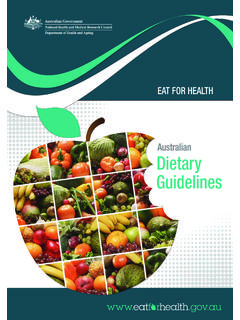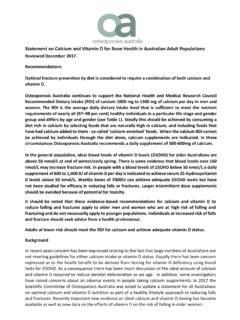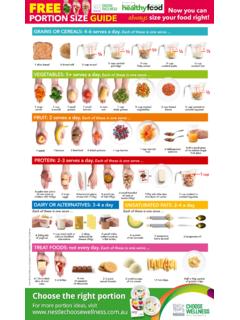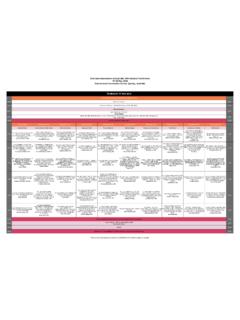Transcription of Educators’ Resource - Healthy Food For All | Home Page
1 educators ResourceA guide to educating the community about nutrition, shopping and cookingAn initiative of Foodbank WA2 educators ResourceAcknowledgementsWritten by Vanessa Bobongie Gemma DevenishThanks to the following people for their contributions, assistance, feedback and advice:Andrea Begley, Sally Blane, Cathy Campbell, Ana Gowrea, Emma Groves, Stephanie McFaull, Rex Milligan and Irene prepared by Insomnia Design, Perth, Western Australia Foodbank WA 2011 This publication is protected by copyright. You may download, print and copy the material in an unaltered form only, with acknowledgement to Foodbank WA for non-commercial purposes. If you wish to use it for any other purpose please contact Foodbank WA. An initiative of Foodbank WA:63 Division St Welshpool 6106PO Box 143 Cloverdale WA 6985 Phone: 9258 9277 Fax: 9258 5177 Email: number: HFFA2011_033 educators ResourceCONTENTS Foodbank WA 4 Who is This Resource For? 5 How to Use This Resource 5 Useful Websites and Contacts 6 Part 1: Nutrition 7 dietary guidelines For Australians 11 The australian Guide to Healthy Eating 14 The Healthy Eating Pyramid 22 Growing Your Own Healthy Food 25 Nutrition Myths 29 I ve Heard 30So How Do I Know What the Truth Is?
2 33 Appendix A: Activities and Resources 35 Part 2: Shopping and Budgeting 82 Food Spending Principles: The 10-Plan 87 Getting More for Your Money 92 Appendix B: Activities and Resources 95 Part 3: Cooking 107 Conducting Cooking Workshops 111An Additional Activity: Cost and Taste Comparison 120 Appendix C: Recipes 123 References 1314 educators ResourceFoodbank WAFoodbank WA is a non-denominational, not-for-profit organisation, established in Perth in 1994. Foodbank WA provides a bridge of support between the food industry and community support agencies looking after Western Australians in need, many of whom are WA is supported by over 500 companies and reaches out to over 600 community agencies. There are regional branches of Foodbank in Albany, Bunbury, Geraldton and WA is continually forging partnerships between business, the food industry, government and the community, to help find solutions to the problem of hunger and poor nutrition in the Western australian more information go to Foodbank WA Food Sensations ProgramThe Foodbank WA Food Sensations program is a practical food budgeting program which has been developed for Foodbank WA s school and community networks.
3 The program incorporates the WA Department of Health FOOD cents nutrition and budgeting Sensations aims to improve knowledge and understanding of nutritious foods, and provide the skills to purchase and prepare them. It covers a range of food related topics including: basic nutrition principles food budgeting food preparation and cooking skills school and community kitchen gardensThe Food Sensations program is open to schools for students, parents, teachers and education assistants; as well as agency representatives and other health more information about Foodbank WA and the Food Sensations program go to: ResourceWho is this Resource for?This Resource has been developed to accompany the Food Sensations program, and to share information, resources and activities with is a wide range of information and resources in this manual that can be used in a school or community setting, with adults or teaching nutrition and cooking, it is hoped that this Resource will be relevant and useful to you, regardless of your background, experience, setting and target to use this resourceThis Resource is divided into three parts:Part 1: NutritionPart 2: Shopping and BudgetingPart 3: CookingEach section is accompanied by an Appendix containing relevant activities, lesson plans and recipes (in Part 3).
4 The Resource does not have to be used in order - you may skip through to the sections that are relevant to is a FREE Resource ; you may photocopy pages and distribute widely, but do not alter the content or layout in any way. This Resource is available to download in sections from the School Breakfast Program website: ResourceUseful WebsitesDietary guidelines for Cancer Council Western of Health & of Health Diabetes Association of thirty WA school breakfast program for 2&5 Foundation Metropolitan Area Health Nutrition Red South Metropolitan Area Health Standards Australia New Zealand (FSANZ) 1: NUTRITION9 educators ResourceCONTENTSI ntroduction 10 dietary guidelines for Australians 11 The australian Guide to Healthy Eating 14 The Healthy Eating Pyramid 22 The Nutrition Information Panel 24 Growing Your Own Healthy Food 25 Nutrition Myths 29I heard about this amazing 29 I ve heard 30organic foods are more nutritious 30chickens are full of hormones 31carbohydrates are bad for you 31eggs are bad for your cholesterol 32avocadoes are unhealthy vegetables 32So how do I know what the truth is?
5 3310 Red Flags of Junk Science 33 Appendix A: Activities, Resources and Handouts 35 The Interactive Pyramid 39 The Healthy Eating Pyramid Worksheet 41 Healthy Eating Crossword 43 Healthy Eating Word Sleuth 46 AGTHE 24 hour Recall Activity 48 Nutrition Information Panel Line-up Activity 57 Take Away vs Homemade Foods 67 Goal Setting Activity and Worksheet 77 Aboriginal and Torres Strait Islander FOOD cents Nutrition Quiz 7910 educators ResourceIntroductionThe Nutrition section of this manual covers the basics of human nutrition, current national guidelines and some explanations of common nutrition myths. Also included in this section is information on growing your own Healthy food, school and community gardens and several activities and resources for use in various school and community teach people, particularly children and adolescents about nutrition and health? It is widely agreed that nutrition and health-related habits formed in childhood are carried into adulthood (Edwards & Hartwell, 2002) (Blanchette & Brug, 2005) (Stables et al.)
6 , 2008) (Powers, Struempler, Guarino & Parmer, 2005) (Fahlman, Dake, McCaughtry & Martin, 2008) Eating a Healthy , nutrient rich diet can aid in maintaining a Healthy body composition, improving mood and sense of wellbeing and avoiding the risk of developing disease or premature death (Perez-Rodrigo, Klepp, Yngve et al., 2001) Increasing fruit and vegetable consumption and quality dietary intake in youth is also associated with reduced cancer risk in adulthood (Stables et al., 2005) In Australia, between 1985 and 1995 childhood obesity tripled in prevalence and is continuing to rise (Laurence, Peterken & Burns, 2007) Overweight adolescents have an 80% chance of becoming overweight adults (Fahlman, Dake, McCaughtry & Martin, 2008)Nutrition is important to maintaining good health. Good nutrition is an important factor in the prevention of chronic diseases and conditions such as obesity, Type 2 diabetes, high blood pressure, high cholesterol, stroke, coronary heart disease, some types of cancer ( colorectal cancer) (National Health and Medical Research Council, 2011).
7 Today there are many different nutrition related messages that come from a variety of sources. Some of these include television, advertising, family and friends, group emails, newspapers, magazines, doctors and so on. There is a lot of nutrition misinformation circulating among the general public, and it can be difficult to determine whether information has come from a credible source or not. The australian Government is addressing these issues with resources such as dietary guidelines for Australians, and the australian Guide to Healthy variety of heath resources can be ordered from: ResourceThe dietary guidelines for AustraliansFood for Health: dietary guidelines for Australians were developed for the australian Government by the National Health and Medical Research Council (NHMRC) in consultation with professionals in the nutrition and food industry. The current edition was published in 2003, and combines the dietary guidelines for australian Adults and the dietary guidelines for Children and Adolescents in Australia in the one document.
8 The dietary guidelines highlight the groups of foods and lifestyle patterns that promote Healthy eating: No guideline is more important than another Each guideline deals with a key health issue and is like a piece of a puzzle. The guide helps you to put the the puzzle pieces together. Nutritional needs differ at different stages of life and these are reflected in the dietary guidelines : - For the newborn there is no better food than breast milk. - Older children need a balance of foods to ensure good growth and development. - The scales are tilted differently to balance eating and physical activity to prevent weight gain. For both children and adults, some principles always remain the same, the need to ensure that food is handled well and is safe to eat; and to enjoy a wide variety of nutritious foods.(NHMRC 2003)The dietary guidelines for Australians are currently under review and are expected to become available in late 201112 educators ResourceThe dietary guidelines for australian Adults are:Enjoy a wide variety of nutritious foods: Eat plenty of vegetables, legumes and fruits Eat plenty of cereals (including breads, rice, pasta and noodles), preferably wholegrain Include lean meat, fish, poultry and/or alternatives Include milks, yoghurts, cheeses and/or alternatives.
9 Reduced-fat varieties should be chosen, where possible Drink plenty of waterand take care to: Limit saturated fat and moderate total fat intake Choose foods low in salt Limit your alcohol intake if you choose to drink Consume only moderate amounts of sugars and foods containing added sugarsPrevent weight gain: be physically active and eat according to your energy needsCare for your food: prepare and store it safelyEncourage and support breastfeedingNational Health & Medical Research Council (NHMRC) 200313 educators ResourceThe dietary guidelines for Children and Adolescents in Australia are:Children and Adolescents need sufficient nutritious foods to grow and develop normally Growth should be checked regularly for young children Physical activity is important for all children and adolescentsEnjoy a wide variety of nutritious foods:Children and adolescents should be encouraged to: Eat plenty of vegetables, legumes and fruits Eat plenty of cereals (including breads, rice, pasta and noodles), preferably wholegrain Include lean meat, fish, poultry and/or alternatives Include milks, yoghurts, cheeses and/or alternatives.
10 Reduced-fat milks are not suitable for young children under 2 years because of their high energy needs, but reduced fat varieties should be encouraged for older children and adolescents Choose water as a drinkand take care to: Limit saturated fat and moderate total fat intake. Low fat diets are not suitable for infants Choose foods low in salt Consume only moderate amounts of sugars and foods containing added sugarsCare for your child s food: prepare and store it safelyEncourage and support breastfeedingNational Health & Medical Research Council (NHMRC) 200314 educators ResourceThe australian Guide to Healthy EatingThe australian Guide to Healthy Eating (AGTHE) (Department of Health & Ageing, 1998) was developed to give Australians information about the types of foods to consume as well as the amount or serving sizes of the types of australian Guide to Healthy Eating uses plate or pie chart model (Figure 1, ). The AGTHE categorises food into groups according to their similar nutrient profiles.





